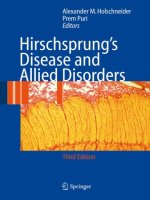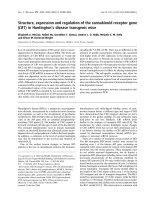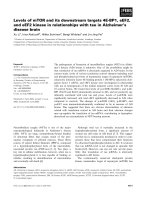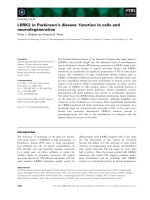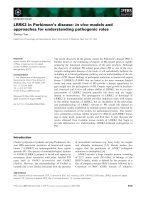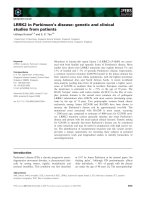Cholinergic innervation and ganglion cell distribution in Hirschsprung’s disease
Bạn đang xem bản rút gọn của tài liệu. Xem và tải ngay bản đầy đủ của tài liệu tại đây (6.59 MB, 11 trang )
Braczynski et al. BMC Pediatrics
(2020) 20:399
/>
RESEARCH ARTICLE
Open Access
Cholinergic innervation and ganglion cell
distribution in Hirschsprung’s disease
Anne K. Braczynski1,2,3,4†, Stefan Gfroerer5†, Rudi Beschorner6, Patrick N. Harter4,7,8,9, Peter Baumgarten4,10,
Udo Rolle11,12 and Michel Mittelbronn4,13,14,15,16*
Abstract
Background: The diagnostic gold standard of Hirschsprung’s disease (HD) is based on the histopathological assessment
of colorectal biopsies. Although data on cholinergic innervation and ganglion cell (GC) distribution exist, only few studies
have examined these two key features together. We assessed the pattern of cholinergic innervation and the amount of
GCs in colorectal specimens of 14 HD patients.
Methods: We established a semi-quantitative score for cholinergic innervation using acetylcholinesterase (AChE) enzyme
histochemistry and quantitatively analyzed the number of GCs via NADH tetrazolium reductase (NADH) enzyme
histochemistry. We examined both the entire length of the resected specimens as well as defined areas of the transition
zone of both pathological and healthy appearing segment.
Results: High AChE score values were associated with absence of GCs, and AChE scores were inversely correlated with
the number of GCs. Nevertheless, we observed several cases in which one of the two features revealed a normal
distribution pattern, whereas the other still displayed pathological features.
Conclusions: Our data support the need for transmural colon biopsies, to enable the best evaluation of both cholinergic
innervation and GCs for a reliable assessment of HD.
Keywords: Hirschsprung’s disease, Colon, Recto-sigmoid, AChE, Aganglionosis
Background
Hirschsprung’s disease (HD) is a rare cause of constipation in infants that is microscopically characterized by
congenital absence of GCs in a variable extension mainly
affecting the rectum and sigmoid colon. HD has a prevalence of approximately 1:5000 in newborns. Male babies
are more frequently affected, with a ratio of 4:1 (male:female) [1]. A register-based study has described a slight
increase in incidence over the recent years [2]. The clinical
symptoms of HD comprise severe chronic constipation,
* Correspondence:
†
Anne K. Braczynski and Stefan Gfroerer contributed equally to this work.
4
Institute of Neurology (Edinger Institute), Goethe University, Frankfurt,
Germany
13
Department of Oncology (DONC), Luxembourg Institute of Health (LIH),
Strassen, Luxembourg
Full list of author information is available at the end of the article
ongoing defecation problems and occasionally bowel obstruction. Most newborns with HD present with a delayed
meconium passage [3]. In infancy, a postnatal passage
time of longer than 24–48 h combined with defecation
problems is clinically suggestive for HD [4]. The treatment
of choice for HD is the surgical resection of the affected
aganglionic segment. The transition zone, which is only
partially populated by GCs, should also be resected. The
operation technique should preserve the anorectal function, which is usually achieved by connecting the distal
functional bowel with the sphincter muscle at the area of
the dentate line [5]. Despite proper surgical treatments,
the quality of life may remain negatively affected during
childhood [6]. Most cases of HD occur sporadically,
nevertheless, genetic causes of this disorder have been
identified [7, 8]. The most frequent mutations affect the
© The Author(s). 2020 Open Access This article is licensed under a Creative Commons Attribution 4.0 International License,
which permits use, sharing, adaptation, distribution and reproduction in any medium or format, as long as you give
appropriate credit to the original author(s) and the source, provide a link to the Creative Commons licence, and indicate if
changes were made. The images or other third party material in this article are included in the article's Creative Commons
licence, unless indicated otherwise in a credit line to the material. If material is not included in the article's Creative Commons
licence and your intended use is not permitted by statutory regulation or exceeds the permitted use, you will need to obtain
permission directly from the copyright holder. To view a copy of this licence, visit />The Creative Commons Public Domain Dedication waiver ( applies to the
data made available in this article, unless otherwise stated in a credit line to the data.
Braczynski et al. BMC Pediatrics
(2020) 20:399
Page 2 of 11
RET gene that codes for a receptor tyrosine kinase [9]. Approximately 50 different RET mutations have been reported in HD patients, accounting for 50% of familial
cases of HD and 15 to 20% of sporadic cases of HD [7].
The diagnosis of HD is histopathologically confirmed by
the absence of GCs in the enteric plexus of the distal rectum (usually several biopsies ranging between 1 and 6 cm
above the dentate line [10–12] via either superficial suction
[13] or a full-thickness (transmural) specimen [14]). Intraoperative diagnostics to detect GCs is most frequently
based on the hematoxylin and eosin (H&E) staining of
cryosections. This method can be combined with enzyme
histochemistry for (i) the assessment of cholinergic nerve fibers using acetylcholinesterase (AChE) [15] and (ii) the detection of ganglion cells via lactate dehydrogenase (LDH),
succinate dehydrogenase (SDH), and NADH tetrazolium
reductase reactions (NADH) [16, 17]. Although average
values exist concerning the number and distribution of ganglion cells in normal intestines and intestines affected by
HD [18], these values are highly dependent on the staining
method [14]. Histopathologically, the diagnosis consists of
an absence of GCs and the presence of hypertrophic
AChE-positive nerve fibers, however little is known about
the correlation of the GC distribution pattern and the cholinergic innervation HD cases. Therefore, in the current
study, we aimed at analyzing both the extent and distribution pattern of cholinergic innervation in the mucosal layer
in relation to the density of GCs in the myenteric plexus in
a cohort of 14 HD patients.
Methods
Patient data
HD patients who were included in this retrospective,
monocentric study underwent transanal pull through
(TAPT) surgeries at the Department of Pediatric Surgery, University Hospital Frankfurt/Main, Germany. In
all cases, the diagnosis of HD was confirmed by transanal rectal biopsies prior to TAPT surgeries. The specimens (for detailed information please see Table 1). were
independently reviewed by at least two experienced neuropathologists (AKB, PNH, MM) from the Institute of
Neurology, according to the diagnostic criteria that were
proposed by Knowles [19]. Patients with long-segment
diseases were excluded from this study. The ages at the
time of the surgeries ranged from 28 days to 25 months
(mean age: 6.5 months). The study cohort consisted of
11 male (m) and 3 female (f) patients.
Ethical statement
The parents of the patients gave written informed consent for the surgery. The use of patient material was
approved by the ethical committee of the Goethe
University Frankfurt, Germany (GN 438/19).
Sampling
Partial colectomy specimens were examined and measured (n = 14). Additionally, each resected bowel segment was macroscopically analyzed with regard to the
changes in diameter in the zones of bowel obstruction.
The length between the proximal resection margin and
the beginning of the dilated colon was documented
(Fig. 1a). Swiss roll specimens were prepared according
to the following guidelines. First, from each of the entire
rectosigmoidal specimens, a longitudinal, 0.5–1 cm wide
strip was excised in paramedian orientation to the antimesocolic tenia. Afterwards, the strip of the intestinal
wall was coiled in caudocranial orientation [20] in cryogel (Tissue Tek O.C.T., Sakura, Alphen aan den Rijn,
Table 1 Sample data
ID
length of aganglionic segment/ total length (cm)
swiss roll
TZ 0 cm
TZ 5 cm
TZ 10 cm
1
7/17
X
X
X
X
2
6/16
X
X
X
X
3
11/25
X
X
X
X
4
5/17
X
X
X
X
5
4/12
X
X
X
6
13/30
X
X
X
X
X
7
15/32
X
X
X
X
X
8
13/25
X
X
X
9
9/19.5
X
10
12/17
X
11
7/25
X
12
28/43
X
13
n.a./12.5
X
14
16/29
X
Abbreviations: X specimen available, n.a. not available
X
X
X
X
X
TZ 15 cm
Braczynski et al. BMC Pediatrics
(2020) 20:399
Page 3 of 11
Fig. 1 Sampling and study design. a Intraoperative aspect of rectosigmoid colon during TAPT procedure. There was a notable change of
diameter at the beginning of TZ (TZ 0 cm). White lines mark the biopsy sites at 5, 10 and 15 cm proximal to the beginning of the transition zone
(TZ 0 cm). (Asterisk indicating aboral/distal end of colon, arrowhead the oral/proximal resection region). b Swiss roll specimens stained for H&E,
AChE, NADH and LDH (asterisk and arrowhead as described in (a)). c First, we analyzed the swiss rolls of the full-length specimens and located
areas with each of the four grades of the AChE-Score. In the same region, we counted GCs. d Second, we analyzed the specimen TZ 0, 5, 10 and
15 cm for their respective AChE-Score (AChE) and counted the GC/mm in the corresponding area (NADH)
Netherlands) attached to a cork plate and snap frozen
(see below). Swiss rolls were then used to analyze the
overall innervation pattern. The “serial biopsies” (referring to the specimens from the transition zone (TZ): TZ
0 cm, 5 cm, 10 cm and 15 cm) were prepared as follows:
the beginning of the change in the diameter was defined
as the beginning of the transition zone and referred to
as TZ 0 cm. A horizontal incisional antimesocolic biopsy
of approximately 3 cm × 1 cm was excised at 0 cm. Further rostral biopsies were performed at 5 cm, 10 cm and
15 cm (TZ 5 cm, TZ 10 cm, TZ 15 cm) (Fig. 1a). The biopsies were fixed in cryogel on the cryostat specimen
holder. All specimens were frozen at − 80 °C in isopentane, which was precooled in liquid nitrogen. Then, 15μm-thick sections were cut with a manual cryostat system (Leica CM 1900, Wetzlar, Germany).
Braczynski et al. BMC Pediatrics
(2020) 20:399
Staining and enzyme histochemistry
Cryosections were stained with H&E, NADH reaction,
LDH reaction and AChE reaction, according to standard
protocols (Fig. 1b). The incubations were performed at
37 °C for 120 min (NADH), 45 min (LDH) and 90 min
(AChE). Stained sections were mounted in Entellan
(Merck Millipore, Darmstadt, Germany).
Scoring
Before performing semi-quantitative and quantitative
analyses, a joint training was done to reduce interobserver variability (AKB, PNH, MM). In case of doubt
during quantification, a joint analysis was performed
until agreement was reached. A semi-quantitative scoring system was applied to evaluate the pathological cholinergic innervation in the mucosal layer (Fig. 1c, d). The
four grades of the AChE score were defined as follows:
score 0, no AChE-positive nerve fibers in the mucosal
layer (Fig. 2a, e); score 1, mild positivity (1 fiber per
crypt within the lamina propria mucosae (LP)) (Fig. 2b,
f); score 2, moderate positivity (up to 2 fibers per crypt)
(Fig. 2c, g) and score 3, strong positivity with 3 or more
fibers per crypt (Fig. 2d, h) in the LP. GCs were counted
within the myenteric plexus using NADH enzyme histochemistry (Fig. 3).
Based on the AChE scoring, two different analyses
were performed. First, we determined the number of
GCs/mm in the NADH stainings in areas corresponding
to each distinct AChE score in the swiss roll (Fig. 1c.
For raw values see Supplementary Table 1). In most
specimens, areas meeting each grade of the AChE score
were present. For the second analysis, transition zone
Page 4 of 11
samples were analyzed for AChE scores, as well as for
the number of GCs/mm in the corresponding area (Fig.
1d. For raw values see Supplementary Table 2). The
length of the myenteric plexus segment was determined
by an open polygon line using image analysis software
analySIS docu (Olympus, Hamburg, Germany). Depending on the quality of the specimens, the amount GCs in
a segment of 20–40 mm were counted. Absolute GC
count was then normalized to the length of the respective myenteric plexus segment to compare GC density in
GC/mm. The imaging and evaluation were performed
using a light microscope (Olympus BX41) at a magnification of 40x (length) or 400x (cell count).
Statistical analysis
For statistical analyses, we used single case overlay diagrams (Fig. 4b). Significance levels were calculated by
using an ANOVA and Tukey’s test (Fig. 4a, c, d). A significance level of α = 0.05 was determined for all tests.
Statistical analyses were performed by using the JMP
11.0 software (SAS, Cary, NC, USA).
Results
AChE score negatively correlated with ganglion cell count
In areas with no AChE-positive nerve fibers in the mucosal layer (score 0; Fig. 5a-c), a median of 17.8 GCs/
mm (min.: 0.9; max.: 35.4) was observed. In areas with
mild AChE positivity (score 1), a median of 5.8 GCs/mm
was counted (min.: 0; max.: 47.2). In areas with moderate AChE positivity (score 2), a median of 0 GCs/mm
(min.: 0; max.: 2.0) was counted. In areas with severe
AChE positivity (score 3; Fig. 5d-f), a median of 0 GCs/
Fig. 2 AChE scores of cholinergic innervation in the lamina propria mucosae. Representative areas of the mucosal layer with cholinergic
innervation. Score 0: absence of AChE-positive fibers (a, e); score 1: mild cholinergic innervation (b, f), score 2: moderate cholinergic innervation
(c, g); and score 3: severe cholinergic innervation (d, h). Scale bar a-d 200 μm; e-h 100 μm
Braczynski et al. BMC Pediatrics
(2020) 20:399
Page 5 of 11
Fig. 3 Ganglion cell count in the myenteric plexus. a and b Healthy bowel areas with normal GC density. Dashed lines indicating GCs. c and d
Classic HD pathology with complete absence of GC. NADH. Scale bar a, c: 500 μm; b, d: 100 μm
mm (min.: 0; max.: 0.8) was observed. There were significant differences in the GC counts when comparing
scores 0 vs. 2 and 0 vs. 3 (each p < 0.001) as well as
scores 1 vs. 2 and 1 vs. 3 (each p < 0.01) (Fig. 4a).
Low AChE score values were associated with a high
number of ganglion cells, but the absence of pathological
cholinergic innervation was not a reliable indicator for a
regular ganglion cell count
Moderate or severe pathological cholinergic innervation
in the LP was associated with complete absence of ganglion cells in the myenteric plexus (Fig. 4b and Fig. 5g-i).
However, the absence of or presence of only very few
AChE positive fibers in the mucosa did not assure a
regular GC distribution in all cases. In 4 out of a total of
14 resection specimens, there were no areas detected
that could be assigned to an AChE score “0”. Furthermore, there were two cases with clear aganglionosis at
the aboral resection margin, however showing no sign of
pathological cholinergic innervation (AChE score 0) in
the respective segment (exemplarily Case ID 5, Fig. 5g-i).
The colonic areas with mild cholinergic innervation corresponding to an AChE score of “1” still exhibited a considerable variation in the GC counts, with variations
between 1.4 GCs/mm (Case ID 7) and 47.2 GCs/mm
(Case ID 2) (Fig. 6).
AChE scores did not continuously decrease in the
transition zone
Serial biopsies from the defined areas within the transition zone were collected (Fig. 1a and d). Depending on
the available material and the lengths of the resected
specimens, the sample counts varied (TZ 0 cm: n = 10;
TZ 5 cm: n = 11; TZ 10 cm: n = 9 and TZ 15 cm: n = 2).
The evaluation of the pathological cholinergic innervation in the transition zone specimens revealed a median
AChE score of 2 at TZ 0 cm (min.: 0; max.: 2), a median
score of 1 at TZ 5 cm (min.: 0; max.: 1), a median score
of 1.5 at TZ 10 cm (min.: 1; max.: 2) and a median score
of 0.5 at TZ 15 cm (min.: 0; max.: 1). The decrease between TZ 0 cm and TZ 5 cm and the increase between
TZ 5 cm and TZ 10 cm were both significant (p < 0.05)
(Fig. 4c).
Ganglion cell counts increased in the proximal region of
the transition zone and remained stable rostrally
The GCs/mm were counted in the transition zone biopsies. At the most distal point of the transition zone (TZ
0 cm), a median of 0 GCs/mm (min.: 0; max.: 5.2) was
observed. At TZ 5 cm, a median of 21.8 GCs/mm (min.:
4.3; max.: 39.8) was counted. At TZ 10 cm, a median of
26.6 GCs/mm (min.: 7.0; max.: 54.4) was observed. Finally, at TZ 15 cm, a median of 32.1 GCs/mm (min.:
Braczynski et al. BMC Pediatrics
Fig. 4 (See legend on next page.)
(2020) 20:399
Page 6 of 11
Braczynski et al. BMC Pediatrics
(2020) 20:399
Page 7 of 11
(See figure on previous page.)
Fig. 4 Analysis of the Swiss Role and AChE score and GC distribution in HD transition zone. a GCs/mm in areas assigned to AChE score 0 to 3 in
the full length swiss roll preparations. b Single case overlay diagram. GCs/mm per AChE score are grouped according to AChE-Score 0 to 3 in a.
In 4 cases no areas with score 0 were detectable. c Cholinergic innervation as measured by the AChE Score and d GCs/mm in the TZ samples (TZ
0 cm, 5, 10 and 15 cm) (*: p < 0.05; **: p < 0.01; ***: p < 0.001)
18.5; max.: 45.7) was counted. There was a significant increase in the the number of GCs/mm between 0 cm and
5 cm (p < 0.01) and between 0 cm and 10 cm (p < 0.001)
(Fig. 4d). Regarding the differences between the other
samples (TZ 5 cm to TZ 10 cm and TZ 10 cm to TZ 15
cm), there was a statistically nonsignificant trend of increasing GC counts, with the difference being the smallest between TZ 10 cm and TZ 15 cm (however, only
n = 2 for TZ = 15 cm).
Discussion
In our cohort of 14 HD patients, we assessed the extent
of cholinergic innervation in the lamina propria mucosae
by AChE scoring, and the number of GCs in colonic biopsies over a maximal length of 15 cm (extending from
the proximal area to the beginning of the macroscopically defined transition zone).
The amount of GCs was in a similar range to those
amounts reported by Meier-Ruge and Brunner [17]. By
using LDH stainings, 7–11 GCs/mm in dys−/or hypoganglionic colon segments, as well as 14.5 GCs/mm in
unaffected colon tissues, were reported [17]. Our slightly
higher cell numbers may be related by the different
staining protocol (NADH instead of LDH). Depending
on the staining method as well as the inter-observer
variability, GC counts can vary considerably [14, 21].
Fig. 5 Discrepancy of ganglion cell count in areas with normal appearing AChE distribution. In general, an AChE score 0 (a) corresponded to GC
population counts as described in [17] (b and c), while an AChE score 3 (d) corresponded to the absence of GCs (e and f). However, case ID 5
showed no cholinergic innervation (AChE score 0, g) associated with absence of GCs (h and i). Scale bar a, d, g 200 μm; b, e, h 1000 μm; c, f,
i 100 μm
Braczynski et al. BMC Pediatrics
(2020) 20:399
Page 8 of 11
Fig. 6 Variation of ganglion cell distribution in cases with similarly pathological AChE reaction. Three cases with AChE Score 1 are shown (a-c:
Case ID 2, d-f, Case ID 13, g-i, Case ID 7). While the amount of pathologic cholinergic innervation is comparable, GC counts per mm varies from
1.4/mm (h-i, Case ID 7) to 47.2/mm (b-c, Case ID 2). Scale bar a, d, g 200 μm; b, e, h 1000 μm; c, f, i 100 μm
Swaminathan et al. summarizes the variation of cell
counts depending on the staining method ranging from
5 to 756 GCs/cm [21]. Even with laborious counting of
the entire circumference, patient-to-patient variation
remained very high [22], suggesting that either significant variation in myenteric GC density is normal or variation in technical factors (e.g., stretch) might be relevant
[21]. The question whether the dilatation of the transition zone and the oral part of healthy gut leads to neuronal death or whether a reduced cell count is the result
of dilatation and stretching (the same amount of CGs
distributed in a wider circumference) remains unsolved.
During TAPT surgery, longitudinal stretching seems to
be more prominent than intravital circumferential
stretching, which is difficult to assess. Another factor is
tissue shrinking during the embedding process, which is
well known from FFPE tissue. This can be neglected in
cryoconserved material as in our case. Current literature
reflects on the disrupted craniocaudal migratory
behaviour of the GCs – and a locoregional partial
phenotype which leads to the reduced amount of GCs in
the transition zone rather than technical factors [23].
Additionally, the work by White and Langer nicely corroborates the findings on circumferential GC count differences [22]. Swaminathan and Kapur examined this
issue in non-HD cadaveric specimens and found that almost the entire circumference of 5 transverse sections
from a single sample had to be counted to get an accurate estimate of GC density [21]. Nevertheless, all published staining and counting techniques were reported
to have high sensitivity and specificity in an experienced
laboratory with accuracy rates as high as 99% [14]. Conventional staining techniques do however not discriminate between GCs and glial bystander cells in the ganglia,
which may result in further variation that is caused by
inadequate GC identification.
Our surgical specimens were sampled in a longitudinal
orientation (from aboral to oral) and the beginning of
Braczynski et al. BMC Pediatrics
(2020) 20:399
the TZ was macroscopically defined based on the end of
the constricted gut. Two phenomena may affect GC
counts: (a) concerning the circumference, some authors
have observed a varying, uneven distribution of the GCs
in the gut wall (see discussion above) [21] and (b) the beginning of the TZ (“0 cm TZ biopsies”). “0 cm TZ” in our
study was macroscopically defined thereby still mainly
showing aganglionic bowel segments. In contrast, defining
the beginning of the transition zone based on microscopic
criteria, a “5 cm TZ biopsy” might be randomly located at
0–5 cm from the aganglionic segment boundary. To reduce the impact of these uncertainties, further research
studies should consider an evaluation of intervals that are
shorter than 5 cm. As expected from normal embryonic
development, our samples showed a longitudinal increase
of GCs in oral direction. We found significant changes in
the transition zone between TZ 0 cm and TZ 5 cm,
followed by a trend of increasing GCs in more proximal
zones. Kapur analyzed the relationship between the length
of the partially aganglionic transition zone, compared to
the length of the aganglionic segment, in 59 patients and
stated that, excluding the very long aganglionic segments,
the hypoganglionic transition zone was consistently less
than 5 cm in length [24]. Nevertheless, there were significant methodological differences in the study design: the
criteria used for the diagnosis of myenteric hypoganglionosis on H&E-stained paraffin sections were descriptive
and designed to detected only moderate-to-severe hypoganglionosis [21]. Despite these formal differences and
limitations regarding to low number of specimens in our
study, our results suggest a relatively longer transition
zone with still slightly increasing GC counts in areas TZ
10 and TZ 15.
In our study, high AChE score values (score 2/3) were
only observed in aganglionic bowel. Absent or low AChE
score values (score 0/1) were mostly associated with a high
number of GCs, but the absence of cholinergic innervation did not prove a normal innervation. Mild cholinergic
innervation has been described in rectal biopsies from patients who did not suffer from HD, possibly because mild
cholinergic innervation is part of the normal variation. Little is known about mild persistent cholinergic innervation
in the LP in HD patients. It is possible that rare AChEpositive neurites also resolve with the maturation of the
child or persist as a normal variant in older children or
adults. Finding rare AChE-positive neurites protruding
into the LP is described to be a relatively common finding
in suction biopsies from pediatric patients who do not suffer from Hirschsprung disease [25–28]. Our findings question that a low amount of remaining AChE positive fibers
(AChE score 1) has to be considered as a reliable pathological feature in HD patients. No significant correlation
was observed between ganglion cell density and absent
(AChE score 0) versus AChE score 1, which extended up
Page 9 of 11
to 15 cm proximally to the aganglionic segment. In four
cases, we did not identify an area with an AChE score of
0. In these cases, some degree of cholinergic innervation
remained, despite a resection margin of up to 15 cm proximal from the TZ. The lack of correlation between ganglion cell density and low AChE score may be based on
the variables discussed above: variability in ganglion cell
counts, different staining protocols, inter-observer variability, tissue stretching and others, or, alternatively, because AChE score 1 might be part of the normal variation.
In our study, we exclusively evaluated transmural biopsies
for both initial diagnosis as well as during definite surgery,
while in other centers, mucosal or submucosal biopsies
may be performed, thus resulting in the risk of insufficient
tissue being collected for definite diagnostics [15]. Because
no definite abnormal cholinergic innervation pattern
(AChE score 2/3) was found in the hypoganglionic bowel
of most HD patients, mucosal AChE activity alone should
not be used to define the proximal transition zone.
Nevertheless, the definition of the end of the transition
zone and the beginning of the normal colon by the use of
GC count cut-off values may not lead to improved surgical patient outcomes, with respect to the inter-observer
variability and methodological differences. Based on our
results, both mucosal and submucosal tissues should be
evaluated, however the choice of the resection margins requires further interdisciplinary discussions.
Conclusion
In our study, we examined the relationship between the
amount of cholinergic mucosal innervation and the density of myenteric ganglion cells in resected intestinal specimens from HD patients. Although we identified an
association between absent GC counts (aganglionosis) and
moderate or high AChE activity, no statistically significant
correlation between AChE activity and ganglion cell
counts in proximal, ganglionic intestinal segments could
be established. Thus, the presence of sparse cholinergic
nerves in the mucosa is not a reliable marker of myenteric
hypoganglionosis and transmural biopsies are essential to
quantify ganglion cells to exclude non-AChE-related features of transition zone. Our data support the high validity
of transmural colon biopsies for HD diagnostics especially
for cases lacking one of the classic features and highlights
the necessity of a close collaboration between pediatric
surgeons and (neuro)pathologists.
Supplementary information
Supplementary information accompanies this paper at />1186/s12887-020-02299-z.
Additional file 1: Table S1. GC count and length of corresponding MP
segment according to AChE score (Swiss Role specimen). Table S2.
Braczynski et al. BMC Pediatrics
(2020) 20:399
AChE score, GC count and length of the corresponding MP segment in
the transition zone
Abbreviations
AChE : Acetylcholinesterase; f: Female; GC : Ganglion cell; H&E : Hematoxylin
and eosin; HD: Hirschsprung’s disease; LDH: Lactate dehydrogenase;
LP: Lamina propria mucosae; m: Male; MP: Myenteric plexus; NADH: NADH
tetrazolium reductase reactions; TZ: Transition zone; TAPT: Transanal pull
through
Acknowledgements
We thank Maika Dunst, Tatjana Starzetz and Cornelia Penski for their
excellent technical assistance. This manuscript was language edited by
American Journal Experts (475E-CB81-4533-A906-6FD4).
Authors’ contributions
The paper is the result of the intellectual collaboration of all listed authors. In
particular, AKB, SG, PNH, UR and MM participated in the conception and
design of the study, drafted the manuscript and performed the neuropathological
analysis. The statistical methods of this study were reviewed by MM. PB followed
up the patients. RB co-supervised the study and gave critical advice concerning
the stainings. SG and UR treated the patients, performed the surgery, supervised
the study and helped interpreting the findings. All authors read and approved the
final manuscript.
Funding
AKB received funding through the START and the rotation program of the
Medical Faculty of RWTH Aachen University. The START rotation fund is a
personal grant to AKB allowing physicians to do research during the
specialization training. MM would like to thank the Luxembourg National
Research Fond (FNR) for the support (FNR PEARL P16/BM/11192868 grant).
The PEARL fund is a personal grant to MM to develop a research program of
excellence in the field of clinical-translational neuropathology.
Availability of data and materials
The dataset supporting the conclusions of this article is included within the
article (and its additional files).
Ethics approval and consent to participate
The use of patient material was approved by the ethical committee of the
Goethe University Frankfurt, Germany (GN 438/19). The parents of the
patients gave written informed consent for the surgery.
Consent for publication
Not applicable.
Competing interests
The authors declare no conflicts of interest.
Author details
1
Department of Neurology, RWTH Aachen University Hospital, Aachen,
Germany. 2Department of Physical Biology, Heinrich-Heine University,
Düsseldorf, Germany. 3Institute of Biological Information Processing (IBI-7:
Structural Biochemistry, Forschungszentrum Jülich, Jülich, Germany. 4Institute
of Neurology (Edinger Institute), Goethe University, Frankfurt, Germany.
5
Department of Pediatric Surgery, Helios Hospital Berlin-Buch, Berlin,
Germany. 6Institute of Pathology and Neuropathology, Eberhard-Karls
University, Tuebingen, Germany. 7German Cancer Consortium (DKTK),
Heidelberg, Germany. 8German Cancer Research Center (DKFZ), Heidelberg,
Germany. 9Frankfurt Cancer Institute (FCI), Frankfurt am Main, Germany.
10
Department of Neurosurgery, Goethe University, Frankfurt, Germany.
11
Department of Pediatric Surgery, University of Frankfurt am Main, Frankfurt,
Germany. 12University Children’s Hospital, Goethe University, Frankfurt,
Germany. 13Department of Oncology (DONC), Luxembourg Institute of
Health (LIH), Strassen, Luxembourg. 14Luxembourg Centre for Systems
Biomedicine (LCSB), University of Luxembourg, Luxembourg City,
Luxembourg. 15National Center of Pathology (NCP), Laboratoire national de
santé (LNS), 1, Rue Louis Rech, L-3555 Dudelange, Luxembourg.
16
Luxembourg Center of Neuropathology (LCNP), 1, Rue Louis Rech, L-3555
Dudelange, Luxembourg.
Page 10 of 11
Received: 1 September 2019 Accepted: 17 August 2020
References
1. Borrego S, Ruiz-Ferrer M, Fernandez RM, Antinolo G. Hirschsprung's disease
as a model of complex genetic etiology. Histol Histopathol. 2013;28(9):
1117–36.
2. Best KE, Addor MC, Arriola L, Balku E, Barisic I, Bianchi F, et al. Hirschsprung's
disease prevalence in Europe: a register based study. Birth Defects Res A
Clin Mol Teratol. 2014;100(9):695–702.
3. Friedmacher F, Puri P. Classification and diagnostic criteria of variants of
Hirschsprung's disease. Pediatr Surg Int. 2013;29(9):855–72.
4. Gfroerer S, Rolle U. Pediatric intestinal motility disorders. World J
Gastroenterol. 2015;21(33):9683–7.
5. Das K, Mohanty S. Hirschsprung disease - current diagnosis and
management. Indian J Pediatr. 2017;84(8):618–23.
6. Collins L, Collis B, Trajanovska M, Khanal R, Hutson JM, Teague WJ, et al.
Quality of life outcomes in children with Hirschsprung disease. J Pediatr
Surg. 2017;52(12):2006–10.
7. Brooks AS, Oostra BA, Hofstra RM. Studying the genetics of Hirschsprung's
disease: unraveling an oligogenic disorder. Clin Genet. 2005;67(1):6–14.
8. de Lorijn F, Boeckxstaens GE, Benninga MA. Symptomatology,
pathophysiology, diagnostic work-up, and treatment of Hirschsprung
disease in infancy and childhood. Curr Gastroenterol Rep. 2007;9(3):
245–53.
9. Edery P, Lyonnet S, Mulligan LM, Pelet A, Dow E, Abel L, et al. Mutations of
the RET proto-oncogene in Hirschsprung's disease. Nature. 1994;367(6461):
378–80.
10. Meier-Ruge WA, Bronnimann PB, Gambazzi F, Schmid PC, Schmidt CP, Stoss
F. Histopathological criteria for intestinal neuronal dysplasia of the
submucosal plexus (type B). Virchows Arch. 1995;426(6):549–56.
11. Meier-Ruge W. Ultrashort segment Hirschsprung disease. An objective picture
of the disease substantiated by biopsy. Z Kinderchir. 1985;40(3):146–50.
12. Holschneider AM, Puri P. Hirschsprung's disease and allied disorders. Berlin
Heidelberg: Springer; 2007.
13. Friedmacher F, Puri P. Rectal suction biopsy for the diagnosis of
Hirschsprung's disease: a systematic review of diagnostic accuracy and
complications. Pediatr Surg Int. 2015;31(9):821–30.
14. Schappi MG, Staiano A, Milla PJ, Smith VV, Dias JA, Heuschkel R, et al. A
practical guide for the diagnosis of primary enteric nervous system
disorders. J Pediatr Gastroenterol Nutr. 2013;57(5):677–86.
15. Meier-Ruge W, Lutterbeck PM, Herzog B, Morger R, Moser R, Scharli A.
Acetylcholinesterase activity in suction biopsies of the rectum in the
diagnosis of Hirschsprung's disease. J Pediatr Surg. 1972;7(1):11–7.
16. Meier-Ruge WA, Bruder E. Pathology of chronic constipation in pediatric
and adult coloproctology. Pathobiology. 2005;72(1–2):1–102.
17. Meier-Ruge WA, Brunner LA. Morphometric assessment of Hirschsprung's
disease: associated hypoganglionosis of the colonic myenteric plexus.
Pediatr Dev Pathol. 2001;4(1):53–61.
18. Knowles CH, Veress B, Kapur RP, Wedel T, Farrugia G, Vanderwinden JM, et al.
Quantitation of cellular components of the enteric nervous system in the
normal human gastrointestinal tract--report on behalf of the gastro 2009
international working group. Neurogastroenterol Motil. 2011;23(2):115–24.
19. Knowles CH, De Giorgio R, Kapur RP, Bruder E, Farrugia G, Geboes K, et al.
Gastrointestinal neuromuscular pathology: guidelines for histological
techniques and reporting on behalf of the gastro 2009 international
working group. Acta Neuropathol. 2009;118(2):271–301.
20. Meier-Ruge WA, Brunner LA, Engert J, Heminghaus M, Holschneider AM,
Jordan P, et al. A correlative morphometric and clinical investigation of
hypoganglionosis of the colon in children. Eur J Pediatr Surg. 1999;9(2):67–74.
21. Swaminathan M, Kapur RP. Counting myenteric ganglion cells in histologic
sections: an empirical approach. Hum Pathol. 2010;41(8):1097–108.
22. White FV, Langer JC. Circumferential distribution of ganglion cells in the
transition zone of children with Hirschsprung disease. Pediatr Dev Pathol.
2000;3(3):216–22.
23. McKeown SJ, Stamp L, Hao MM, Young HM. Hirschsprung disease: a
developmental disorder of the enteric nervous system. Wiley Interdiscip Rev
Dev Biol. 2013;2(1):113–29.
24. Kapur RP. Histology of the transition zone in Hirschsprung disease. Am J
Surg Pathol. 2016;40(12):1637–46.
Braczynski et al. BMC Pediatrics
(2020) 20:399
25. Schofield DE, Devine W, Yunis EJ. Acetylcholinesterase-stained suction rectal
biopsies in the diagnosis of Hirschsprung's disease. J Pediatr Gastroenterol
Nutr. 1990;11(2):221–8.
26. Moore SW, Johnson G. Acetylcholinesterase in Hirschsprung's disease.
Pediatr Surg Int. 2005;21(4):255–63.
27. Pacheco MC, Bove KE. Variability of acetylcholinesterase hyperinnervation
patterns in distal rectal suction biopsy specimens in Hirschsprung disease.
Pediatr Dev Pathol. 2008;11(4):274–82.
28. Chow CW, Chan WC, Yue PC. Histochemical criteria for the diagnosis of
Hirschsprung's disease in rectal suction biopsies by acetylcholinesterase
activity. J Pediatr Surg. 1977;12(5):675–80.
Publisher’s Note
Springer Nature remains neutral with regard to jurisdictional claims in
published maps and institutional affiliations.
Page 11 of 11
